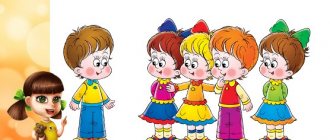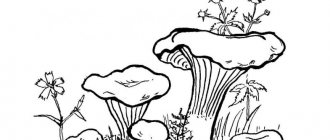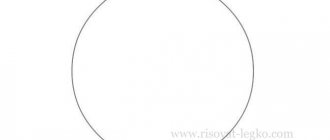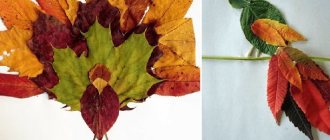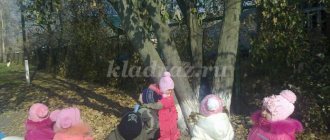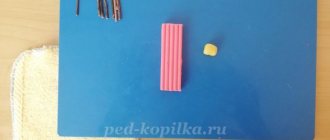Summary of a logic club lesson in kindergarten. Middle group
Lesson notes for the “Logic” club in the middle group “Visiting the Dwarves”
Area of cognition. Author:
Gudkova Victoria Vladimirovna, teacher of the 1st qualification category of MDOU No. 136 combined kindergarten.
Goal: Development of logical and mathematical thinking. Objectives: Develop the ability to identify properties in objects, abstract these properties from others, compare objects according to given properties.
Develop the ability to compare objects based on independently identified properties. Develop the ability to follow certain rules when solving practical problems, independently create an algorithm for the simplest actions (linear algorithm). Progress of the lesson
Educator . Guys, today I want to tell you about two gnomes - Bim and Bom. Gnome Bim lives in a house with a brown roof, and gnome Bom lives in a house with a red roof (attach the pictures to the magnetic board). They love to visit each other, but one day it rained very heavily and large puddles appeared between the gnomes’ houses (attach the pictures to the magnetic board). Now gnomes cannot visit each other. Let us help them. Children. Yes, we need to help the gnomes. Educator. Let's use our magic pebbles (blocks) to build a path between the houses. To make our path beautiful, I suggest placing pebbles of different thicknesses next to each other. Task 1 (Children build a path from Dienesh’s logical blocks so that there are no blocks of the same thickness nearby). Educator. Well done! A path was built between the gnomes' houses. Now they can visit each other again. Guys, gnomes love to play different games with each other. Their favorite game is dominoes, but it is broken. One of the figures (show cards - “dominoes” and geometric shapes). Let's help the gnomes fix their favorite game. Children. Let's help. Educator. To fix it, you and I need to select a figure from the circles, rectangles, squares and triangles that are in the box that is somewhat similar to the figure on the card, and place it in the empty window. Task 2 (Children select a figure for each domino card and place it in the second half of the card. Explain how the two figures are similar to each other.) Educator. The game has been fixed, well done! Guys, the gnomes really want there to be a pond near their houses in which fish would swim. The gnomes have already bought fish (show fish), but they don’t have a pond yet. Let us help the gnomes and dig a fish pond. Do you agree? Children. Yes! Educator. Okay, but before we start work, you and I need to rest a little. Physical education lesson In the morning, the gnomes went into the forest, and along the way they found a mushroom. And behind him - one, two, three - Three more appeared! And while the mushrooms were being picked, the gnomes were late for school, they ran, hurried, and dropped all the mushrooms! Educator. We rested, let's get to work (perform movements with the children several times, as if we were digging the ground with a shovel). So, the pond was dug (attach the picture to the magnetic board). All that remains is to decorate the shore with our pebbles. With the help of magic cards and arrows, the gnomes wrote to us what color, shape and size pebble should lie behind which. Task 3 Children build a path according to the rule. Educator. Well done! The pond was dug and the shore was decorated. Now you can release the fish into the pond. Let's help Bim and Bom launch the fish. First we will release the yellow fish, then the red fish and last we will release the blue fish.
We recommend watching:
Summary of a lesson in the middle group on the works of Marshak Notes of the GCD in the middle group “Help the Cockerel” Summary of the GCD in the middle group on the topic: “Who lives in the little house?” Summary of a design lesson in the middle group "Tumbler"
Similar articles:
Math lesson “Rectangle” in the middle group of kindergarten
Project “Logic for children 4-5 years old”
Explanatory note
The need for the purposeful formation of logical methods of thinking in the process of teaching and upbringing is already recognized by psychologists and teachers. Famous child psychologist L.S. Vygotsky was one of the first to formulate the idea that a child’s intellectual development lies not so much in the quantitative stock of knowledge, but in the level of intellectual processes, i.e., in the qualitative features of children’s thinking. He argued: “Scientific concepts are not absorbed and memorized by a child, they are not taken into memory, but arise and are formed with the help of the tension of the entire activity of his own thought.” But why should a preschooler develop thinking? The fact is that at each age stage, a certain “floor” is created, on which mental functions that are important for the transition to the next stage are formed. Thus, the skills and abilities acquired in the preschool period will serve as the foundation for acquiring knowledge and developing abilities at an older age. And the most important among these skills is the skill of logical thinking, the ability to “act in the mind.” Having mastered logical operations, the child will become more attentive, learn to think clearly and clearly, be able to concentrate on the essence of the problem at the right moment, and convince others that he is right. It will become easier to study, which means both the learning process and school life itself will bring joy and satisfaction. Knowledge of logic will contribute to the cultural and intellectual development of the individual.
A child who has not mastered the techniques of logical thinking will find it more difficult to study: solving problems and doing exercises will require a lot of time and effort. As a result, the child’s health may suffer and interest in learning may weaken or even disappear completely.
Modern pedagogical and methodological literature offers teachers a variety of techniques that stimulate the intellectual development of preschoolers. However, in the literature it is difficult to find a comprehensive set of tools, techniques and methods, the totality of which makes it possible to ensure the manufacturability of this process. The practice of working with children of senior preschool age has revealed that children often cannot identify signs of generalization by naming the generalizing concept itself; cognitive activity is often reduced, and this inhibits the development of a creative personality. In my opinion, the most constructive solution to the problem is the idea that the systematic development of forms and operations of logical thinking on material accessible to children in a playful form contributes to the development of children’s cognitive activity, creative and logical thinking, independence and systematic thinking.
Target:
development of logical thinking of a preschooler through play activities: teach by playing.
Tasks:
- Develop visual perception, attention, memory, logical thinking of children.
- Develop visual-figurative thinking.
- Develop the skill of reasoning, drawing conclusions, contrasting, comparing, analyzing, and establishing simple patterns.
- To develop the ability to find and complete missing fragments of images, to identify an object by individual parts.
- Foster independence, initiative, and perseverance in achieving goals.
The project was developed for children of middle preschool age (4-5 years old).
Project implementation period
- one year.
Expected Result
:
- The ability to independently and persistently achieve goals has been developed.
- Children show curiosity and interest in research activities.
- Children have developed attention, perception, and logical thinking.
- Children successfully solve logic problems.
- Preschoolers show a steady interest in educational games.
- Developed ability to analyze, reason, compare, and draw conclusions.
Plan of joint activities with children of the middle group to develop mental abilities through didactic games and exercises
| month | tasks | activity logic | ||
| October lesson 1 | 1. Strengthen the ability to quickly find a geometric figure. 2.Develop the ability to find the missing figure. 3. Exercise children to lay out cars according to a pattern. | 1.I/u “Find and name.” 2.I/u “Complete the figure.” 3. Designing machines from geometric shapes | ||
| lesson 2 | 1. Practice finding geometric shapes. 2.Develop voluntary attention. 3. Exercise children to lay out the fish according to the pattern. | 1.I/u “Find and name.” 2.I/u “Find the missing figure” (complete the figure). 3.Laying out the fish according to the pattern. | ||
| lesson 3 | 1. Exercise children in drawing up geometric figures on a table from a count. sticks and threads 2. Exercise children to lay out a pattern using sticks. | 1.I/u “Make a figure: a square and a triangle; small and large square; from threads circle, oval, triangle, square. 2. Laying out the pattern according to the sample. | ||
| lesson 4 | 1.Practice in composing geometric shapes. 2.Develop the ability to compose figures according to a model. 3.Develop logical thinking and attention. | 1.Make: 2 equal triangles from 5 sticks; Of 10 sticks, 3 are equal squares; Of 7 sticks, 2 are equal squares. I/u “What’s missing.” Name the missing figure | ||
| november lesson 1 | 1.Consolidate knowledge about geometric shapes. 2.Develop the ability to arrange figures according to instructions. 3.Train children to find objects, develop attention and observation. | 1.Color the shapes that have 3 corners and the extra shape. 2. Arrange the figures: red circle, to the left of it is a yellow triangle, to the right of the circle is a green triangle; 3. Cards (noisy) - finding objects. | ||
| lesson 2 | 1.Develop logical thinking. 2.Develop voluntary attention. | 1.I/u “What’s outside, what’s inside” 2.I/u “Make it according to the model.” 3.I/u “Sequence” Arrange the cards according to the pattern. | ||
| lesson 3 | 1. Exercise the ability to compose new geometric shapes 2. Develop attention and observation. | 1.Introduction to the tangram game. 2.I/u “Which figure is extra.” | ||
| lesson 4 | 1.Develop logical thinking. 2.Develop voluntary attention | 1.I/u “Outlining” 2.I/u “Make it according to the model.” 3. I/u “Find the differences” | ||
| December lesson 1 | 1.Use buttons to develop verbal and logical thinking. 2.Develop logical thinking, voluntary attention 3.Train children to find an extra object | I/u “Find the extra button” a) extra in color b) extra in size c) extra in the number of holes d) extra in shape D/i “Paired rugs” D/i "The Fourth Wheel" | ||
| lesson 2 | 1.Develop voluntary attention. 2.Develop attention and observation skills 3.Train children to find objects, develop attention and observation. | I/u "Contours" D/i "Rezinochki" Cards (noisy) - finding objects | ||
| lesson 3 | 1. Practice composing geometric shapes 2. Develop voluntary attention | I/u “Make a square” I/u "Outlining" | ||
| January lesson 1 | 1.Practise drawing up the geometric shape of a square 2.Use buttons to develop verbal and logical thinking 3.Develop logical thinking. | I/u “Make a square” I/u “Continue the row of buttons” a) red and blue buttons alternate b) 2 red and 2 blue buttons alternate c) blue, red, orange buttons alternate d) buttons with different numbers of holes alternate D/i “What’s wrong” | ||
| lesson 2 | 1.Use buttons to develop verbal and logical thinking 2.Develop voluntary attention 3.Train children to find an extra object | I/U “Find a button according to the description”" a) Find a small red button b) Find a large black button with 4 holes c) Find a small white button with 4 holes d) Find a large blue button with 2 holes I/U “Find an extra object » 3 D/i “The Fourth Wheel” | ||
| February lesson 1 | 1.Use buttons to develop verbal and logical thinking 2.Develop attention and observation skills 3.Develop voluntary attention | I/U “Add buttons to the rows” What buttons are missing in each row? Make sure there are equal numbers of buttons in all rows. I/u “Find the missing figure” (complete the figure) I/u “Make it according to the model.” | ||
| lesson 2 | 1.Develop attention and observation skills 2Train children to find an extra object 3.Develop attention and observation skills | D/i "Find the differences" D/i "The Fourth Wheel" D/i “Rubber bands (2nd option) | ||
| lesson 3 | 1.Practise making geometric shapes from sticks according to the pattern 2.Use buttons to develop verbal and logical thinking 3.Develop attention and observation skills | I/u “Make it according to the model.” I/u “Logical operation" a) arrange the buttons: red ones in one circle, small ones in another; b) arrange the buttons: with 4 holes in one circle, small ones in the other. D/I “What did the artist mix up” | ||
| March lesson 1 | 1.Use buttons to develop verbal and logical thinking 2.Develop voluntary attention 3.Develop logical thinking. | I/u “Put the buttons into bags” a) arrange the buttons by color b) arrange the buttons by size c) arrange the buttons according to the number of holes I/u "Labyrinths" D/i “What’s wrong | ||
| lesson 2 | 1Train children to find objects, develop attention and observation. 2.Develop logical thinking. 3.Develop voluntary attention | Cards (noisy) - finding objects D/i "Sequence" I/u “Make it according to the model.” | ||
| lesson 3 | 1.Develop the ability to arrange figures according to instructions. 2.Develop voluntary attention 3.Train children to find an extra object | I/u “Make it according to the model.” I/u "Find the differences" D/i "The Fourth Wheel" | ||
| lesson 4 | 1.Practise drawing up the geometric shape of a square 2.Develop logical thinking and attention 3.Develop voluntary attention | I/u “Make a square” (Option 2) I/u “What’s missing.” Name the missing figure I/u “Make it like this” | ||
| April lesson 1 | 1.Practise the ability to compose figures according to a model 2.Develop logical thinking and attention 3Exercise children in making figures on the table from counting. sticks according to the pattern | D/i "Tangram" I/u “What’s missing.” Name the missing figure I/u “Make a figure | ||
| lesson 2 | 1.Develop voluntary attention 2.Develop attention and observation skills 3.Develop attention and observation skills | I/u "Labyrinths" D/I “What did the artist mix up” I/u “Find the missing figure” (complete the figure) | ||
| lesson 3 | 1.Develop attention and observation skills 2.Develop voluntary attention 3Train children to find an extra object | I/u “Find an item that doesn’t fit with the others” D/i "Silhouettes" D/i "The Fourth Wheel" | ||
| lesson 4 | 1Develop the ability to coordinate a pronoun with a noun. 2Develop attention and observation skills 3Practise the ability to compose figures according to a model | Speech game “Settled in houses” D/i “What is what” D/i "Tangram" | ||
Final event:
game – quiz “Smart guys and smart girls”
Bibliography:
BEHIND. Mikhailov "Game entertaining tasks for preschoolers", Moscow "Enlightenment" 2009. V.P. Novikova “Mathematics in kindergarten”, Moscow Mosaic-Synthesis 2009. “500 tasks and tasks for children”, Creative Center Sphere 2009. E.N. Petlyakov “Developing memory and attention”, Phoenix Rostov-on-Don 2012.
https://psi-school.ru/logicheskie-igry-s-pugovicami/
https://www.babyblog.ru/community/post/parentalschool/3169149
https://mirdetstva5.ru/obschii-zanyatiya-s-rebyonkom/razvivayuschaya-igra-chto-pereputal-khudozhnik#
https://ot2do6.ru/77-volshebnaya-obvodilka.html
https://www.liveinternet.ru/users/svetlana-sima/post213452433/
https://mirdetstva5.ru/obschii-zanyatiya-s-rebyonkom/razvivayuschaya-igra-chego-ne-khvataet
https://prodetstvo.ru/games/log/log4/
https://vk.com/smart_children
